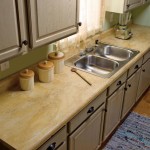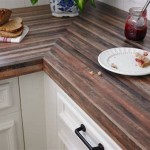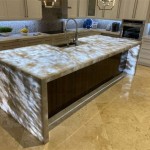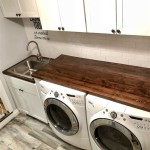How to Get Stains Off Granite Countertops
Granite countertops are a highly desirable feature in kitchens and bathrooms due to their durability and aesthetic appeal. However, despite their robust nature, granite is still susceptible to staining if spills are not addressed promptly. The porous nature of natural stone, even when sealed, allows liquids to seep into the surface, leading to unsightly marks. Understanding the types of stains commonly found on granite and the appropriate cleaning methods is crucial for maintaining the beauty and longevity of this valuable surface.
The effectiveness of any stain removal method depends on several factors, including the type of stain, the duration it has been present, and the level of sealing applied to the granite. A proactive approach, involving regular cleaning and prompt spill cleanup, is the best defense against persistent staining. This article provides a comprehensive guide on identifying and removing various types of stains from granite countertops, ensuring they remain pristine for years to come.
Identifying the Stain
Before attempting to remove a stain from a granite countertop, it is essential to identify the type of stain. Different substances require different cleaning methods, and using the wrong approach can exacerbate the problem or even damage the stone. Stains are generally categorized as organic, oil-based, or mineral-based.
Organic stains are caused by substances such as coffee, tea, wine, fruit juice, and food spills. These stains often appear as brownish or yellowish discolorations on the granite surface. Organic stains tend to be absorbed into the stone, making them more challenging to remove than surface stains.
Oil-based stains result from spills of cooking oil, grease, cosmetics (like lipstick or foundation), or oily foods. These stains often appear darker than the surrounding granite and can have a greasy or oily texture. Oil-based stains penetrate deeply into the stone's pores, making them particularly stubborn to remove.
Mineral-based stains are caused by hard water deposits, rust, or other mineral-rich liquids. These stains typically appear as white or reddish-brown discolorations on the granite surface. Mineral-based stains can be difficult to remove, especially if they have been present for an extended period.
In addition to these common categories, other types of stains can occur on granite countertops. These include ink stains, caused by pens or markers; biological stains, resulting from mold or mildew growth; and chemical stains, caused by acidic cleaners or corrosive substances. Identifying the specific source of the stain is crucial for selecting the appropriate cleaning method.
General Cleaning and Preventative Measures
Regular cleaning is paramount for maintaining the appearance and preventing stains on granite countertops. This includes wiping up spills immediately and routinely cleaning the surface with a pH-neutral cleaner specifically designed for natural stone. Avoid using abrasive cleaners, acidic solutions (such as vinegar or lemon juice), or bleach, as these can damage the sealant and etch the stone.
For daily cleaning, a simple solution of warm water and a mild dish soap is often sufficient. Apply the solution to the countertop with a soft cloth or sponge, then rinse thoroughly with clean water and dry with a clean cloth. This simple routine removes surface dirt and grime, preventing it from accumulating and potentially causing stains.
Using cutting boards and trivets is another essential preventative measure. Cutting directly on the granite surface can scratch the stone, while placing hot pots and pans directly on the countertop can damage the sealant and potentially cause heat-related stains. Trivets protect the granite from heat, and cutting boards prevent scratches and spills from contaminating the surface.
Sealing granite countertops regularly is crucial for preventing stains. The frequency of sealing depends on the type of granite and the level of use the countertop receives. A general recommendation is to seal granite countertops every one to two years. A simple water test can determine if resealing is necessary. To perform the test, place a few drops of water on the countertop. If the water beads up, the sealant is still effective. If the water darkens the stone or is absorbed quickly, it is time to reseal the granite.
Specific Stain Removal Techniques
When a stain occurs, prompt action is necessary to minimize its impact. The following are techniques for removing different types of stains from granite countertops.
Removing Organic Stains: For organic stains like coffee, tea, or juice, start by blotting the stain immediately with a clean cloth or paper towel. Avoid rubbing, as this can spread the stain. Next, create a paste using baking soda and water. Apply the paste to the stain and cover it with plastic wrap. Leave the paste on the stain for several hours or overnight.
After the paste has had sufficient time to work, remove the plastic wrap and gently wipe away the paste with a damp cloth. Rinse the area thoroughly with clean water and dry with a clean cloth. If the stain persists, repeat the process or consider using a poultice (described below) designed for removing organic stains.
Removing Oil-Based Stains: Oil-based stains require a different approach due to their deep penetration into the stone's pores. Absorbent materials are necessary to draw the oil out of the granite. A poultice, a pasty substance designed to draw out stains, is effective for removing oil-based stains.
To create an oil-based stain poultice, mix a powdered absorbent material such as diatomaceous earth, baking soda, or cornstarch with a solvent such as acetone or mineral spirits. The mixture should have a thick, paste-like consistency. Apply the poultice to the stain, covering it completely. Cover the poultice with plastic wrap and tape the edges to secure it. Allow the poultice to dry completely, which may take 24 to 48 hours.
Once the poultice is dry, carefully scrape it off the granite surface with a plastic scraper. Rinse the area thoroughly with clean water and dry with a clean cloth. Inspect the area for any remaining stain. If the stain is still visible, repeat the poultice process. In some cases, multiple applications may be necessary to completely remove the stain.
Removing Mineral-Based Stains: Mineral-based stains, such as rust or hard water deposits, typically require acidic cleaners for removal. However, using acidic cleaners on granite can damage the stone, so caution and careful application are necessary.
Begin by trying a mild solution of distilled water and a pH-neutral cleaner designed for natural stone. Apply the solution to the stain and scrub gently with a soft brush. Rinse thoroughly with clean water and dry with a clean cloth. If this method is ineffective, consider using a poultice made with a commercial rust remover or a solution of lemon juice and baking soda. Apply the poultice to the stain, cover it with plastic wrap, and allow it to sit for several hours before rinsing and drying.
When using any acidic cleaner, it is crucial to test it in an inconspicuous area first to ensure it does not damage the granite. Apply a small amount of the cleaner to the test area and observe for any discoloration or etching. If no damage occurs, proceed with caution, applying the cleaner only to the stained area and rinsing thoroughly afterward.
Removing Other Types of Stains: Removing ink stains can be tricky. Try using a cotton ball dampened with rubbing alcohol or acetone to gently blot the stain. Be careful not to spread the ink. Follow with a thorough rinsing and drying. For biological stains like mold or mildew, clean the area with a solution of diluted bleach (one part bleach to ten parts water), ensuring adequate ventilation and wearing protective gloves. Rinse thoroughly after cleaning.
Creating and Applying a Poultice
A poultice is a highly effective method for removing deep-seated stains from granite countertops. It works by drawing the stain out of the stone's pores through absorption. As mentioned earlier, the poultice consists of a powdered absorbent material mixed with a solvent or cleaning agent. The choice of absorbent material and solvent depends on the type of stain being treated.
For oil-based stains, suitable absorbent materials include diatomaceous earth, baking soda, cornstarch, and fuller's earth. The solvent can be acetone, mineral spirits, or even dish soap mixed with water. For organic stains, baking soda or diatomaceous earth can be used with a solution of hydrogen peroxide or ammonia. For rust stains, diatomaceous earth or whiting mixed with a commercial rust remover is effective.
To create a poultice, mix the chosen absorbent material with the selected solvent or cleaning agent until a thick, paste-like consistency is achieved. The paste should be thick enough to hold its shape when applied to the countertop. Apply the poultice generously to the stained area, covering it completely. The poultice should extend slightly beyond the edges of the stain to ensure complete absorption.
Cover the poultice with plastic wrap to prevent it from drying out too quickly. Tape the edges of the plastic wrap to the countertop to secure it in place. Allow the poultice to sit on the stain for 24 to 48 hours, or even longer for stubborn stains. During this time, the absorbent material will draw the stain out of the granite's pores. The drying process is crucial for the poultice to function properly. As the poultice dries, it pulls the stain along with it.
After the poultice has dried completely, carefully scrape it off the granite surface with a plastic scraper. Avoid using metal scrapers, as they can scratch the stone. Rinse the area thoroughly with clean water and dry with a clean cloth. Inspect the area for any remaining stain. If the stain is still visible, repeat the poultice process until the stain is completely removed.
After removing the stain, consider resealing the granite in the affected area. The cleaning process, especially when using solvents or acidic cleaners, can strip away the sealant, leaving the stone vulnerable to future staining. Resealing helps to protect the granite and maintain its beauty.

How To Get Stains Out Of Granite Counters No Scrubbing

How To Remove Stains From Granite Stone Care International

How To Remove Hard Water Stains From Granite Countertops Professional Results At Home

How To Get Stains Out Of Granite Counters No Scrubbing

How To Clean Seal And Polish Granite Countertops Pro Housekeepers

Smells Like Food In Here Clean Rust Stain From Granite Countertop

Granite Countertop Slabs Tips To Remove Water Marks

How To Clean Granite Countertops Diy Cleaner

How To Clean Countertops The Home

The Best Way To Clean Granite Countertops








